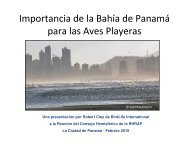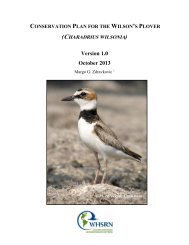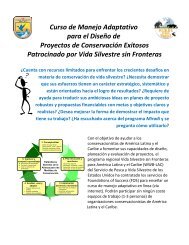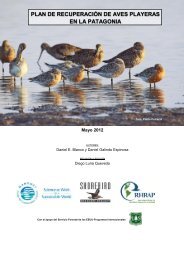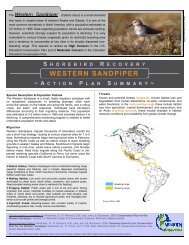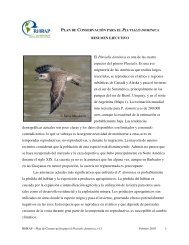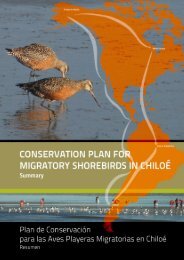Sanderling Plan - Western Hemisphere Shorebird Reserve Network
Sanderling Plan - Western Hemisphere Shorebird Reserve Network
Sanderling Plan - Western Hemisphere Shorebird Reserve Network
Create successful ePaper yourself
Turn your PDF publications into a flip-book with our unique Google optimized e-Paper software.
years before the planned modification of natural habitat (Davidson and Evans 1987;<br />
Buchanan 2000). This 5-year period is needed to: 1) identify suitable sites; 2) acquire,<br />
design, and construct mitigation features at sites; 3) allow suitable sediments to settle and<br />
stabilize; and 4) allow time for colonization of sufficient densities of invertebrate prey<br />
species (Davidson and Evans 1987).<br />
o Evaluate shorebird use of artificial impoundments - Artificially created sites may be very<br />
important to shorebirds, and should be evaluated using the same approach as for<br />
undisturbed sites (Warnock and Takekawa 1995).<br />
o Create adequate roost sites – Although most shorebirds (including the <strong>Sanderling</strong>)<br />
appear to prefer beaches (or salt marshes) as roost sites, they also use dredge-spoil islands<br />
and other human-created areas. Artificial sites should provide shelter from strong winds<br />
or sea swell, and be open with flat tops and gently sloping sides (to allow for effective<br />
scanning for predators; Metcalfe 1984).<br />
o Manage artificial (freshwater) sites during fall migration – During fall migration,<br />
shorebirds use draw-downs, flooded agricultural lands, and artificial fish ponds. Gradual<br />
draw-downs in shallow [0–5 centimeters (0–2 inches) deep] flood pools should be<br />
interspersed with exposed saturated soils and should be maintained for the duration of fall<br />
migration.<br />
o Maximize invertebrate production at artificial (freshwater) sites – Artificial<br />
impoundments will be most effective if site features maximize invertebrate production<br />
and shorebird foraging efficiency.<br />
RESEARCH AND MONITORING NEEDS<br />
Research and monitoring needs for North America are highlighted in numerous state,<br />
regional, and national shorebird planning documents, and by the <strong>Shorebird</strong> Research Group of<br />
the Americas (SRGA website). Regional <strong>Plan</strong>s of the U.S. <strong>Shorebird</strong> Conservation <strong>Plan</strong> describe<br />
comprehensive as well as regionally focused research needs; other documents highlighting<br />
research needs for the <strong>Sanderling</strong> include habitat Joint Ventures and State Wildlife Action <strong>Plan</strong>s.<br />
Research priorities important to the survival of the <strong>Sanderling</strong> include:<br />
o determining limiting factors on breeding, migration, and wintering grounds;<br />
WHSRN – <strong>Sanderling</strong> Conservation <strong>Plan</strong>, February 2010, v1.1 58




